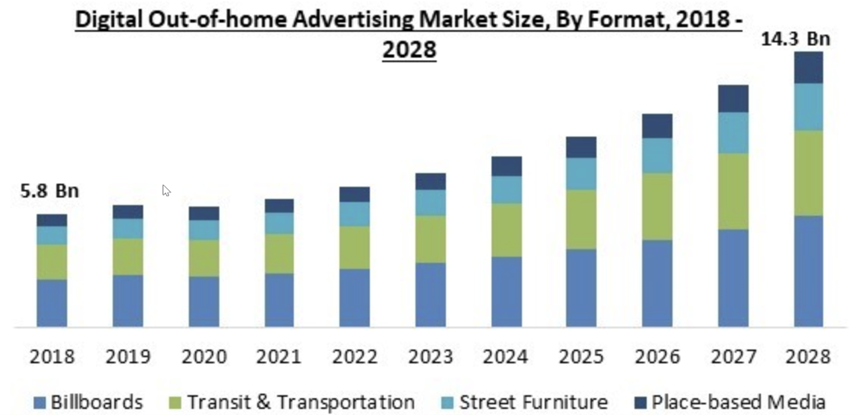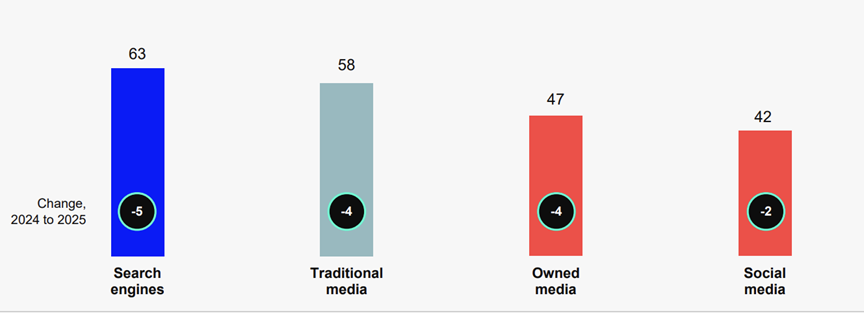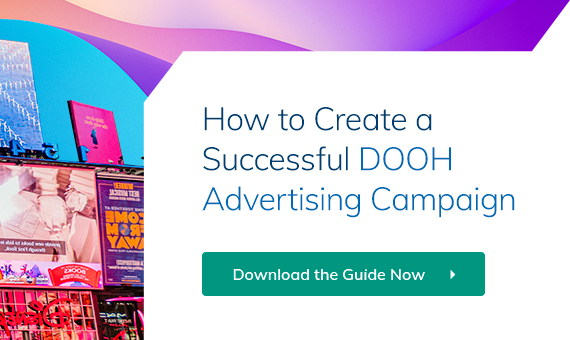Is 2025 the year DOOH advertising finally overtakes social media ad spend?
Marketing agencies face a critical decision. Should they continue pouring budget into potentially diminishing returns from social media, or capitalize on the explosive growth of Digital Out-of-Home (DOOH) advertising?
This article explores how programmatic DOOH, driven by real-time data and AI-powered platforms, offers a compelling alternative, delivering impactful real-world engagement and a potent blend of reach and precision.
The rise of DOOH advertising
Digital Out-of-Home (DOOH) advertising refers to digital media displayed in physical spaces. Think digital billboards, bus stops, shopping malls, airports and gyms.
These screens have evolved from static formats into highly targeted, data-driven canvases, delivering dynamic, contextually relevant messages.
According to the Out of Home Advertising Association of America (OAAA), DOOH advertising enjoys high consumer favorability, with 73% of consumers viewing the ads positively.
Even more compelling, 76% of consumers report taking action as a result of seeing a DOOH ad, highlighting its effectiveness in driving real-world results.
To cement its position in an agency’s channel armory, eMarketer projects U.S. DOOH ad spend is expected to grow by 11.5% to $3.54 billion in 2025. This growth rate is more than double that of traditional out-of-home (OOH) advertising, highlighting the increasing shift towards digital formats in the advertising industry.

Image source: kbvresearch.com
Programmatic DOOH. Precision meets scale
Programmatic DOOH (pDOOH) brings digital era automation and targeting to the physical world. Instead of booking static slots weeks in advance, agencies can use programmatic platforms to:
- Trigger ads based on real-world data (weather, traffic, events)
- Target audiences using mobile device data and geolocation
- A/B test creatives and adjust in near-real-time
- Pause or scale campaigns across DOOH inventory, instantly
This fusion of physical presence and digital precision offers unmatched agility. And while social media has long been praised for its targeting capabilities and real-time optimization, pDOOH is rapidly closing that gap, offering many of the same programmatic benefits, but with the added impact of large-format, real-world visibility.
The question isn’t just whether DOOH can match social media’s precision, but whether it can surpass it by combining data-driven targeting with physical scale and brand-safe environments.
So let’s take a deeper look.
DOOH -v- social media: A side by side comparison
1. Engagement and trust
Consumers are becoming increasingly wary towards social media advertising. Many social ads now suffer from “banner blindness,” with Meta reporting that ad engagement on Facebook has declined year over year due to saturation.
In contrast, DOOH delivers its message in an unobtrusive, context-relevant way often when audiences are in a mindset for discovery.
A Nielsen study found that DOOH ads drive 2.5x higher brand lift than static OOH.
Trust is another differentiator.
According to the Edelman Trust Barometer, trust in social platforms has declined steadily, particularly around misinformation and data privacy concerns.
The decline of social media

Image source: Edelman Trust Barometer 2025
Meanwhile, DOOH is generally viewed as “in the public domain,” giving it a sense of both credibility and transparency.
2. Cost-effectiveness and ROI
While social media platforms offer cheap CPMs, the true cost lies in ad fatigue and diminishing returns.
With the average consumer inundated with 4,000–10,000 ads per day, predominantly on digital platforms, standing out has become prohibitively expensive.
This saturation leads to a decreasing return on investment for social media campaigns.
By contrast, DOOH provides a more “premium” moment of exposure.
Ads are often larger-than-life, unskippable and impossible to block.
And with programmatic buying, marketers can access inventory cost-effectively, with no minimum spends or upfront commitments.
According to PwC’s Global Entertainment and Media Outlook, DOOH’s compound annual growth rate will outpace all other traditional ad segments through 2026.
3. Audience reach and context
Social media’s reach is enormous but it’s limited by algorithms and screen size. Most users scroll quickly, muting or ignoring ads.
DOOH reaches consumers in high-dwell environments, whether waiting at stations, stuck in traffic or queuing at stores, when they’re not glued to a second screen. This leads to higher ad recall and contextual relevance.
Modern DOOH platforms can also sync messaging across screens.
For example, a consumer might see a DOOH ad during their commute, followed by a remarketing ad on mobile via geofencing or a QR code Call to Action.
When to use DOOH -v- social media
|
Campaign Type |
Recommended Channel |
Why It Works |
Metrics for Success |
|
Brand Awareness |
DOOH |
High visibility, public trust, mass exposure |
Reach, impressions, brand lift studies, website traffic increase |
|
Tactical Promotions |
Social + DOOH (combined) |
DOOH triggers; social drives deeper action |
DOOH: Foot traffic, sales lift Social: clicks, conversions, engagement |
|
Retargeting |
Social |
Lower funnel activation |
Conversion rates, cost per acquisition |
|
Event Countdown |
DOOH |
Location-specific countdowns drive urgency |
Attendance, sales during event period |
|
B2B Positioning |
DOOH in Business Zones |
Reaches execs in key decision-making moments |
Lead generation, brand perception surveys, increased RFPs |
Let’s remember though that for agencies, channels often need to be blended to achieve client results and DOOH and social media are not mutually exclusive.
Smart marketers will use them together.
For example, DOOH excels at capturing attention and raising brand awareness in high-traffic urban environments, whilst social media is often more effective at nurturing interest once awareness has been established. In this sense, DOOH acts as the top-of-funnel catalyst, sparking curiosity and recognition, while social media serves as the mid-to-lower-funnel tool for building consideration and driving conversions.
A new channel hierarchy in 2025?
As digital ecosystems shift toward privacy, contextual marketing, and media diversity, DOOH is now an established pillar in omnichannel campaigns.
Its blend of impact, trust, and precision amplified by AI and programmatic buying makes it an attractive choice for marketing agencies seeking performance without platform fatigue.
Social media isn’t going away any time soon but it’s no longer the only game in town.
Key takeaways for agencies:
- Evaluate DOOH as a strategic awareness driver, not just a branding tool.
- Integrate DOOH into omnichannel workflows, syncing with social, mobile, and CRM for full-funnel performance.
- Use platforms like The Neuron to tap into global inventory with programmatic precision. Simplify your buying and targeting.
As your agency plans their media mix for 2025, it’s worth considering whether you are spending too much in noisy digital channels and too little where consumers are truly paying attention.
Are your ads visible where they matter most?
The Neuron platform. Your AI advantage
The Neuron stands at the forefront of AI-powered DOOH delivery, enabling marketers to:
- Tap into 1.1 million premium displays globally
- Access real-time analytics on campaign performance
- Leverage AI for optimal creative rotation and targeting
The platform supports automated creative optimization, real-time bidding, and advanced contextual triggers making it a true plug-and-play solution for agencies. Moreover, the ease of use of the platform caters to those who are familiar with DSPs and RTB in digital media, as well as agencies who are new to the market.


